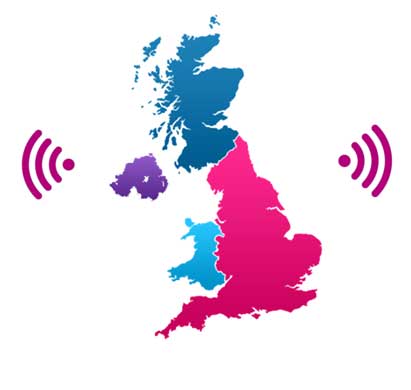White Space Is The Next Evolution In Wireless Technology
 Just because Wi-Fi is available almost everywhere doesn’t mean we’re going to get complacent and stop developing new wireless technology. The possible next phase of Wi-Fi, “white space,” will be piloted in the UK in the next six months.
Just because Wi-Fi is available almost everywhere doesn’t mean we’re going to get complacent and stop developing new wireless technology. The possible next phase of Wi-Fi, “white space,” will be piloted in the UK in the next six months.
White space connectivity involves using spectral buffer zones, or gaps in the frequency band, to transmit broadband and inter-machine communications. These spectral buffer zones reside in the frequencies that broadcast digital television, and the white spaces are gaps that aren’t currently being used by broadcasters or other applications. Devices that use white space would communicate with a central database that monitors the frequencies, ensuring that the white space devices don’t interfere with any technologies that happen to be using the space. Basically, it’s a way to leverage the spectrum more than we have so far. White space availability depends on location and the number of devices that access the spectrum at any given time. Currently, using these white spaces doesn’t require a license.
Ofcom, an independent UK-based communications regulator and authority, believes these underutilized spaces are the next step in providing Wi-Fi to remote places and to improving its availability everywhere else. Thus, Ofcom has designed and developed the trial, inviting 20 organizations to participate. The trial will test a slew of wireless innovations, including city-monitoring sensors that give real-time information to residents and broadband for remote locations. Ofcom recently released the list of companies it will work with in piloting these technologies.
BT and Neul will team up with the UK Department of Transport to work on enhancing traffic information. They’ll use white spaces to send information about traffic conditions to drivers and vehicles with an aim to alleviate traffic congestion and improve safety.
Microsoft will also participate in the pilot to determine how white space could provide free Wi-Fi to residents of Glasgow, which currently has the lowest broadband use of any city in the UK. Microsoft will partner with the University of Strathclyde, which happens to have a Centre for White Space Communications, to determine the feasibility of making Glascow a “smart city” by linking sensors in a network of white space.
Ofcom also has internet service providers and database providers participating in its pilot. The ISP Click4internet will test the use of white space to boost broadband in rural places, including areas made virtually inaccessible by foliage or other difficult terrain. Bluetooth and Wi-Fi have trouble reaching these remote areas, especially when mountains and hills are involved, but white space radio waves can travel longer distances and can travel through objects because they are frequencies that, until now, have been allocated for TV use. The database providers, including Google, will test “intelligent” databases that will make sure the use of white space won’t interfere with other devices or signals.
The UK, like the US, has a growing demand for Wi-Fi services, which Ofcom hopes white space will be able to satisfy. The use of white spaces also supports machine-to-machine communications, which Ofcom and other tech organizations predict will increase dramatically in the coming years. Ofcom hopes to be at the forefront of spectrum innovations, believing that “spectrum is the raw material that will underpin the next revolution in wireless communications” and that everything from cars to crops to coffee machines will communicate via the spectrum.
The drawback is that the spectrum isn’t infinite, which is why using the white spaces is a potentially ground-breaking innovation. Anything that will prevent us from running out of connectivity options is welcome news, considering our increasing obsession with and dependence on wireless technology.












